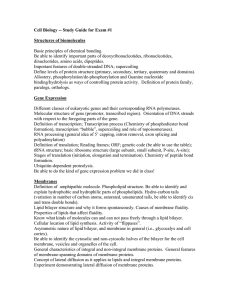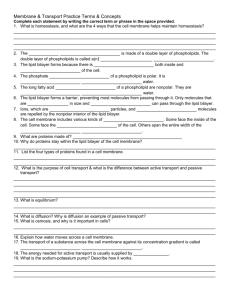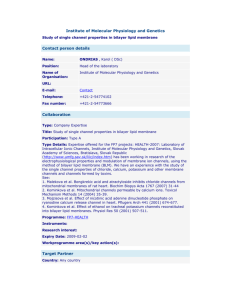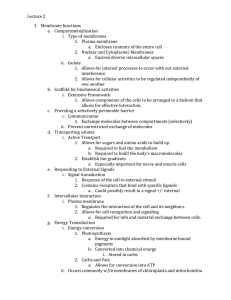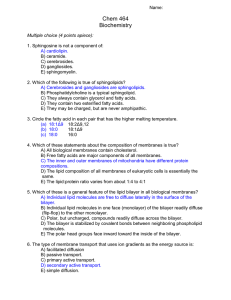Kevin Ahern's Biochemistry Course (BB 350) at Oregon State University
advertisement
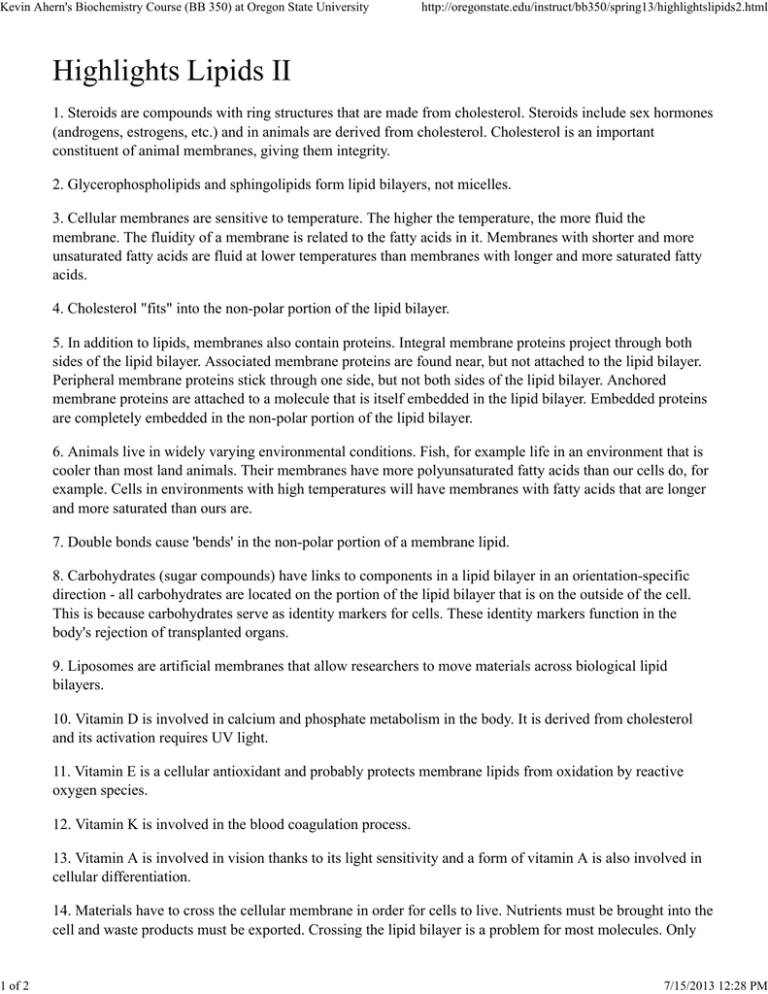
Kevin Ahern's Biochemistry Course (BB 350) at Oregon State University 1 of 2 http://oregonstate.edu/instruct/bb350/spring13/highlightslipids2.html Highlights Lipids II 1. Steroids are compounds with ring structures that are made from cholesterol. Steroids include sex hormones (androgens, estrogens, etc.) and in animals are derived from cholesterol. Cholesterol is an important constituent of animal membranes, giving them integrity. 2. Glycerophospholipids and sphingolipids form lipid bilayers, not micelles. 3. Cellular membranes are sensitive to temperature. The higher the temperature, the more fluid the membrane. The fluidity of a membrane is related to the fatty acids in it. Membranes with shorter and more unsaturated fatty acids are fluid at lower temperatures than membranes with longer and more saturated fatty acids. 4. Cholesterol "fits" into the non-polar portion of the lipid bilayer. 5. In addition to lipids, membranes also contain proteins. Integral membrane proteins project through both sides of the lipid bilayer. Associated membrane proteins are found near, but not attached to the lipid bilayer. Peripheral membrane proteins stick through one side, but not both sides of the lipid bilayer. Anchored membrane proteins are attached to a molecule that is itself embedded in the lipid bilayer. Embedded proteins are completely embedded in the non-polar portion of the lipid bilayer. 6. Animals live in widely varying environmental conditions. Fish, for example life in an environment that is cooler than most land animals. Their membranes have more polyunsaturated fatty acids than our cells do, for example. Cells in environments with high temperatures will have membranes with fatty acids that are longer and more saturated than ours are. 7. Double bonds cause 'bends' in the non-polar portion of a membrane lipid. 8. Carbohydrates (sugar compounds) have links to components in a lipid bilayer in an orientation-specific direction - all carbohydrates are located on the portion of the lipid bilayer that is on the outside of the cell. This is because carbohydrates serve as identity markers for cells. These identity markers function in the body's rejection of transplanted organs. 9. Liposomes are artificial membranes that allow researchers to move materials across biological lipid bilayers. 10. Vitamin D is involved in calcium and phosphate metabolism in the body. It is derived from cholesterol and its activation requires UV light. 11. Vitamin E is a cellular antioxidant and probably protects membrane lipids from oxidation by reactive oxygen species. 12. Vitamin K is involved in the blood coagulation process. 13. Vitamin A is involved in vision thanks to its light sensitivity and a form of vitamin A is also involved in cellular differentiation. 14. Materials have to cross the cellular membrane in order for cells to live. Nutrients must be brought into the cell and waste products must be exported. Crossing the lipid bilayer is a problem for most molecules. Only 7/15/2013 12:28 PM Kevin Ahern's Biochemistry Course (BB 350) at Oregon State University 2 of 2 http://oregonstate.edu/instruct/bb350/spring13/highlightslipids2.html oxygen, carbon dioxide, carbon monoxide and water readily diffuse across the lipid bilayer. 15. Mechanisms for moving materials across the lipid bilayer are Passive (= diffusion - no external energy required) or Active (energy required). The driving force for a passive mechanism is concentration driven (movement from high concentration to low). 16. Active transport mechanisms require energy to move compounds across a membrane because they are taking materials against concentration gradients (low to high). There are a variety of energy sources, but ATP is a common one. 17. The sodium-potassium pump is an active transport system that transports sodium from inside the cell to outside of it. The sodium-potassium pump also transports potassium from outside the cell to the inside. Since both of these movements involve taking a substance from a lower concentration and moving it to a higher concentration, energy is required and this mechanism is an active transport mechanism. It uses ATP. 18. A secondary transport system is an active transport system that uses a high concentration of a molecule outside the cell to "carry" a molecule with it across a membrane and against a concentration gradient. An example is the lactose transport system which uses a proton gradient to carry lactose against a concentration gradient. Proton gradients like this are also used by cells to make ATP, so there is energy that can be used when a gradient is formed. 19. Proteins on the cell surface can also act as 'receptors'. An example of a receptor that internalizes a compound is the LDL receptor, which binds to LDLs (cholesterol-containing complexes in the blood) and brings them inside of the cell. 7/15/2013 12:28 PM

